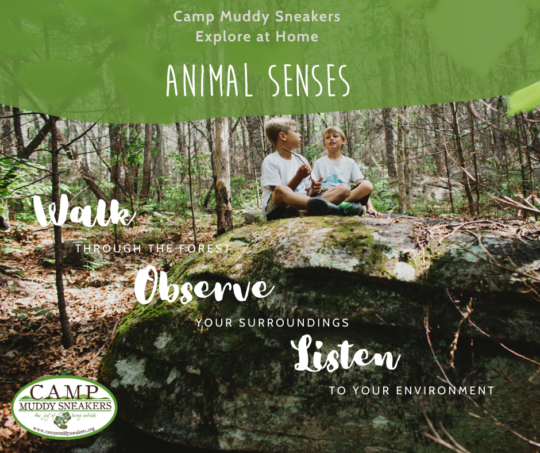Expand Your Animal Senses!
We love helping our campers find joy in immersing themselves in the natural world. Join us in our favorite animal awareness exercises by learning to listen like a deer, walk like a fox, and watch the world like an owl!
Listen Like a Deer
Many animals native to North Carolina have a sense of hearing much more powerful than ours, including the White-Tailed Deer. To listen like a deer, cup your hands (with your fingers all together) and put them behind your ears. This amplifies even the smallest sounds whether you’re in a forest, your backyard, or your living room! To test out your “deer ears,” listen for a noise without assistance and give your senses a boost by putting your cupped hands up to your ears. Are sounds louder when you listen like a deer? Can you hear bird calls, rustling leaves, or croaking toads more clearly? To test out the distance of your “deer ear” amplification, find a family member to be your “noisemaker.” Put your deer ears up, stand facing your noisemaker, and close your eyes. Have your family member make an animal noise and take a few steps backward. Raise your hand every time you hear your noisemaker and test out how far away they can get before you no longer hear them!
Walk Like a Fox
As humans, we mostly explore the world through our hands, and don’t often think about how our feet explore our environment. Wild animals however have incredibly sensitive feet that allow them to walk silently through the forest. Foxes such as North Carolina’s native Grey Fox are especially good at sneaking softly through the woods. Try your hand (or foot) at walking like a fox:
- Take a short, slow step and place only the outside edge of your foot on the ground. (If this is difficult, try placing toes down first)
- Gently roll your foot down flat
- Slowly move your weight forward
- Repeat with the other foot…
When you fox-walk, you will feel the ground before actually putting your weight on that foot. As you practice, try to freeze mid-step like a fox might. Imagine you are a fox and you hear another animal look at you, or you hear the alarm call of a bird. As you walk, feel for sticks that might break under you: then pick your foot up and place it in a new spot before the stick snaps. Remember, move slowly, and keep your eyes pointing at the world in front of you (not below). If you have different surfaces near your home, try fox walking on them all. Does it feel different to walk like a fox on dirt vs. gravel, grass vs. dead leaves, sandy soil vs. mud?
Watch Like an Owl
Did you know that owls have developed eyes so large, their eyes have outgrown their eye sockets and are “frozen” in place? We can’t physically expand our eyes, but we can still expand our senses and watch the world like an owl. Stand still and find an object straight ahead of you to focus on. Imagine your eyes are stuck in place, and cannot move from side to side. If you find yourself looking away from your object or focus point, bring your vision (and your eyes) back to center. Without moving your eyes (and while focusing on your object) notice what else is visible: you can likely see the sky or ceiling, and the ground or floor. You’ve just found your peripheral vision, and your owl eyes!
Practice building on this by noticing the farthest thing you can see to the left, and to the right while still keeping your eyes focused on that first object. Try lifting your hands into the air in front of you, and wiggling your fingers. Keep your eyes focused on your original object, and slowly move your hands away from your central field of vision, and towards your peripheral vision to the left, and right. How long can you continue to see your wiggling fingers? Can you see them if they are 45 degrees from your central object, how about 90?

